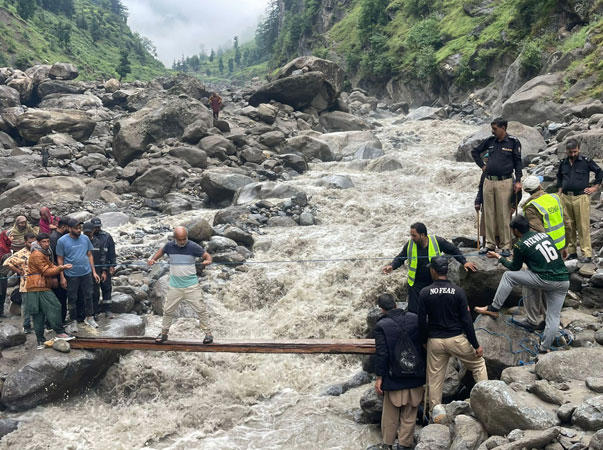Over 200 Killed as Monsoon Rains Devastate Khyber Pakhtunkhwa, Northern Pakistan

Peshawar, The Gulf Observer: Torrential monsoon rains, cloudbursts and landslides of unprecedented scale have devastated upcountry areas of Pakistan, leaving more than 200 people dead within 24 hours, officials confirmed on Friday. Survivors described the catastrophe as resembling “doomsday,” as entire communities were swept away, homes destroyed, and families lost in an instant.
According to the National Disaster Management Authority (NDMA), at least 194 deaths were officially recorded nationwide — 180 in Khyber-Pakhtunkhwa (K-P), nine in Azad Jammu and Kashmir (AJK), and five in Gilgit-Baltistan (G-B). Among the victims were 19 women and 17 children, most killed by collapsing houses or sudden flash floods. However, local reports suggested the toll in K-P alone had risen to 214, including 157 in Buner district, the worst-hit area.
K-P Chief Secretary Shahab Ali Shah confirmed 100 deaths in Buner, where flood emergencies were declared across Daggar, Gadezai, Gagra, Mandanr and Chagharzai subdivisions. In Bajaur, a midnight cloudburst and lightning strike demolished four houses in Jabrai village, killing 21 people, many from the same families. In Mansehra’s Shimlai area, a cloudburst destroyed 10 homes, washing them into the Nandhar stream and killing over 25 residents, most belonging to a single family. Shangla, Swat and Battagram also reported dozens of deaths and widespread destruction.
Infrastructure damage has been severe. Entire villages were inundated, the Alpuri-Bisham highway washed away in multiple places, and more than 35 power towers toppled, plunging parts of Shangla into darkness. Graveyards, shops and homes were swept away, while tourists and residents stranded in northern regions had to be rescued from swollen rivers and submerged roads.
National Emergency Response
The K-P government declared Buner, Bajaur, Mansehra, and Battagram as disaster-hit areas and announced a day of mourning. Prime Minister Shehbaz Sharif convened an emergency meeting, directing the NDMA to deploy all resources in support of K-P’s rescue and relief operations. Chairman NDMA Lt Gen Inam Haider Malik briefed him on ongoing operations, while the Prime Minister ordered the immediate delivery of tents, medicines, food and other relief supplies.
The Pakistan Army has also mobilised significant resources. Army Chief Field Marshal Syed Asim Munir instructed troops to fully support relief operations, deploying additional contingents, helicopters, engineers, and Urban Search and Rescue teams. Temporary bridges are being installed to restore access to cut-off areas, while 600 tons of army rations and one day’s salary from all personnel have been allocated for flood victims.
Forecast Worsens Outlook
The Pakistan Meteorological Department (PMD) warned of further heavy rains in upper K-P, the Potohar region, and Kashmir, raising fears of additional floods and landslides. Authorities cautioned the public to avoid rivers, streams, and unnecessary travel, while tourists were advised against visiting northern areas for at least a week.
Meanwhile, landslides in G-B blocked the strategic Jaglot-Skardu road at multiple points, with clearance operations underway. Officials warned that the monsoon, which began earlier than usual, is expected to persist longer this year, with intensifying rains over the next 15 days likely to worsen the crisis.
PM Pledges Support
During a call with K-P Governor Faisal Karim Kundi and Chief Minister Ali Amin Gandapur, Prime Minister Shehbaz Sharif assured the province of federal support. “The federal government will provide all possible assistance to the provincial government,” he said, extending condolences to the victims.
As Pakistan braces for more rains, the nation mourns one of the deadliest natural disasters in recent years, with emergency responders racing against time to rescue survivors and provide relief amid overwhelming devastation.


